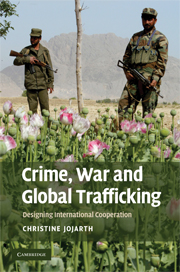Book contents
- Frontmatter
- Contents
- List of figures
- List of tables
- List of abbreviations
- Preface and acknowledgments
- 1 Introduction
- 2 The concept of legalization
- 3 Problem constellation
- 4 Narcotic drugs: UN Convention against Illicit Traffic in Narcotic Drugs and Psychotropic Substances
- 5 Money laundering: the Financial Action Task Force and its Forty Recommendations
- 6 Conflict diamonds: the Kimberley Process Certification Scheme
- 7 Small arms and light weapons: the United Nations Program of Action
- 8 Conclusion
- References
- Index
5 - Money laundering: the Financial Action Task Force and its Forty Recommendations
Published online by Cambridge University Press: 02 July 2009
- Frontmatter
- Contents
- List of figures
- List of tables
- List of abbreviations
- Preface and acknowledgments
- 1 Introduction
- 2 The concept of legalization
- 3 Problem constellation
- 4 Narcotic drugs: UN Convention against Illicit Traffic in Narcotic Drugs and Psychotropic Substances
- 5 Money laundering: the Financial Action Task Force and its Forty Recommendations
- 6 Conflict diamonds: the Kimberley Process Certification Scheme
- 7 Small arms and light weapons: the United Nations Program of Action
- 8 Conclusion
- References
- Index
Summary
Unknown as a legal concept until the 1980s, money laundering developed from “one of the buzz phrases . . . in the 1990s” (Gold and Levi 1994: 7) into a veritable “roar” in this decade (Beare 2001). Policymakers' growing interest in this phenomenon reflects their increasing disillusionment with the war against drug trafficking and other forms of organized crime and their hope that confiscation and anti-money laundering policies could provide them more effective – possibly even self-financing – tools for attacking the financial “soft belly” of criminal networks. It was immediately clear to policymakers that they had to join forces across borders to counter the fast advancing integration of financial markets and the many new and truly global opportunities this trend offered for criminals and terrorists to create a legitimate appearance for their “dirty” money. Less than a year after money laundering was first addressed in a legally binding international agreement – namely in the Vienna Convention studied in the previous chapter – the leaders of the then G-7 countries agreed to establish the so-called Financial Action Task Force as a platform for coordinating and strengthening their efforts to “follow the money” (Wechsler 2001) and to “take profit out of crime.”
I will argue in the following that these cooperative anti-money laundering (AML) efforts are fraught with a paradoxical problem constellation, resulting in contradictory design expectations. On the one hand, the level of asset specificity is high, stemming from a rather asymmetric distribution of costs and benefits among states.
- Type
- Chapter
- Information
- Crime, War, and Global TraffickingDesigning International Cooperation, pp. 139 - 180Publisher: Cambridge University PressPrint publication year: 2009



